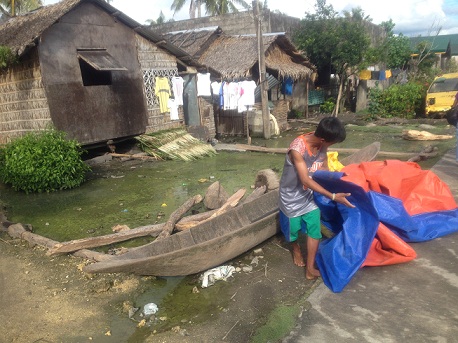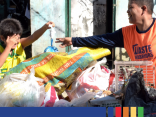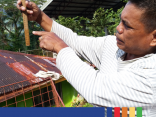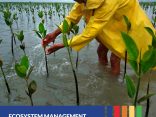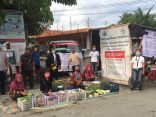(This report was first published online by VERA Files on 18 October 2014. Original version is available in this link. Also published here on Yahoo Philippines' The Inbox )
By Jake Soriano, VERA Files
NAGA, Camarines Sur — The night before Typhoon Gloria (international name Rammasun) battered its way through Barangay Ponong in Magarao, Camarines Sur, local chief Bobby Abad was busy warning his constituents to leave for the nearest evacuation centers.
Typhoon winds were already strong by the time he finished his duties. He went home when his job was done, only to find the roof of his house swept away by gusts.
In photo: Even without typhoons, impoverished Barangay Ponong is at risk to flooding because of its topography. (Jake Soriano)
(This report was first published online by VERA Files on 18 October 2014. Original version is available in this link. Also published here on Yahoo Philippines' The Inbox )
By Jake Soriano, VERA Files
NAGA, Camarines Sur — The night before Typhoon Gloria (international name Rammasun) battered its way through Barangay Ponong in Magarao, Camarines Sur, local chief Bobby Abad was busy warning his constituents to leave for the nearest evacuation centers.
Typhoon winds were already strong by the time he finished his duties. He went home when his job was done, only to find the roof of his house swept away by gusts.
“Kapag punong barangay ka kasi, sa iyo lahat ang sisi pag may namatay [When you’re head of the barangay, you are held responsible for the casualties],” he tearfully tells an audience of local government officials and disaster risk reduction stakeholders in one of the activities of the “Ugnayan at Bahaginan” forum here in Naga.
Putting local government units at the forefront of reducing risks and managing disasters is one of the many improvements introduced with the enactment in March 2010 of Republic Act No. 10121, or the Philippine Disaster and Risk Reduction Management Act.
Four years in its implementation, however, weaknesses in the law are starting to show. Foremost among them is a budget model that is dependent on Internal Revenue Allotments (IRA), thus perpetuating inequality by keeping impoverished communities with very minimal funds unable still to enact plans and policies to manage risks and disasters.
The case of Barangay Ponong is illustrative of this. Lying five meters below sea level and situated along the Bicol River basin, many zones in Ponong are vulnerable not just to typhoons. Regular high tides are enough to flood houses.
R.A. No. 10121 provides that local government units allocate five percent of their IRA for disaster and risk reduction. Seventy percent of this fund should go to disaster preparedness programs, while 30 percent would constitute a quick response fund which can only be used in cases of disasters.
But Ponong is located in Magarao, a fourth class municipality in terms of income classification. The barangay’s total annual IRA is only roughly around P1.4 million. Five percent of this amount is P70,000 and further breaking this down using the proportion set by law means Ponong has P49,000 for disaster preparedness and P21,000 for relief efforts.
For Typhoon Glenda relief alone, Ponong has already used P18,000, according to Abad. The remaining amount was allocated for evacuation tools, which so far consists of a rope and a padyak to help transport residents to designated safe centers.
“Kulang na kulang [The funds are really lacking],” bemoans Abad.
There are options for poor LGUs, according to Marieta Lupig Alcid, executive director of non-governmental organization Assistance and Cooperation for Community Resilience and Development Incorporated (ACCORD), which organized the “Ugnayan at Bahaginan” forum.
“May resource pooling. Yung mga capable na LGUs have the option na i-share sa iba yung funds na hindi nila nagamit [There’s a resource pooling option where well-off LGUs could share unused funds to other government units],” she says.
“Kaya lang, ito ay voluntary, no. Hindi sya obligation [The problem is, this is voluntary. Local governments are not obliged to do this],” she explains.
In 2015, or five years after its implementation, R.A. No. 10121 will undergo a sunset review. This evaluation is a provision in the law itself to allow for “a systemic evaluation” to enable Congress to determine if remedial legislation is necessary.
“We believe that the allocation for disaster preparedness funds should be according to the level of vulnerability, not on the economic capacity of the LGU concerned,” notes Alcid.
She adds that it is imperative for LGUs and civil society to participate in this said review mechanism to ensure that the concerns of the most vulnerable communities are taken into consideration in improving the country’s disaster and risk reduction management frameworks.
The poorest barangays in the country, like Ponong, are most often the same ones that continue to bear the brunt of the devastating disasters.
Reforms are therefore needed, says Alcid, to ensure that “[these vulnerable communities] receive the maximum support of the government and their countrymen in strengthening their resilience.”
In photo: Even without typhoons, impoverished Barangay Ponong is at risk to flooding because of its topography. (Jake Soriano)
Even without typhoons, impoverished Barangay Ponong is at risk to flooding because of its topography. – See more at: http://verafiles.org/ira-dependent-budget-model-keeps-poorest-communities-most-vulnerable-to-disasters/#sthash.umrPBBYC.dpuf

